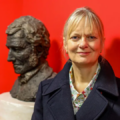A conversation with Matthias Smalbrugge on the future of religion
Religion at a crossroads: A conversation with Matthias Smalbrugge on the future of religion
In an interview with the European Academy on Religion and Society (EARS), Professor Matthias Smalbrugge, a distinguished scholar in religious studies and theology, and President of EARS, discusses religion’s current struggles and potential future both in Europe and globally. Despite being challenged by social constructs such as nationalism and neoliberalism, and the rise of a saturated image culture, religion is unlikely to disappear. Smalbrugge suggests that religion will evolve to meet the inherent human needs for transcendence, community, and shared memory. Smalbrugge’s insights offer a thought-provoking perspective on the future of religion in a changing world.
The future of religion hangs in the balance. Faced with secularisation, nationalism, social divisions, and a world dominated by visuals, organised religion finds itself challenged as never before. Yet, inherent human needs for transcendence, community, and shared memory suggest that religion, however it evolves, is unlikely to disappear. The interview with Professor Matthias Smalbrugge, a distinguished scholar in religious studies and theology at the Vrije Universiteit Amsterdam and President of EARS, provides illuminating insights into religion’s current struggles and potential future.
Lost memory, the future, and the power of images
“It is a very difficult moment for religions,” Smalbrugge observes. Modern societies seem to have lost a unified sense of their past – a shared sense of memory and history. This loss, compounded by unhealed historical wounds like those caused by colonialism and slavery, continues to fester. Such divisions born from historical memory – or rather, the lack thereof – create large divides that tear our common history apart. These wounds affect the collective identity and continuity of communities, hindering their ability to move beyond them. Addressing these deep-seated issues is crucial, not just for religion’s sake, but for the future of societies.
Smalbrugge expands on this, stating: “Memory is composed of what is remembered and what is forgotten. This is a selective procedure, we forget something for a reason. But as it is forgotten, it is mostly very difficult to understand what was the reason to forget what we have forgotten.” He points out examples of selective memory within the Christian tradition: the forgetting of Gnosticism due to its perceived threat to orthodoxy, and the suppression of desire, which has since been rediscovered as central to the doctrine of the Trinity. Crucially, he observes that women stand as symbols of what has been forgotten and suppressed within Christianity.
“Memory is composed of what is remembered and what is forgotten.”
A fragmented historical consciousness undermines how religion is experienced and understood in contemporary contexts. It impacts how religious narratives and identities are constructed and perceived. Smalbrugge poses a key question: “We are a culture based on images … So what do we, theologians, have to say about our modern culture?” He highlights a major challenge for religious thought to confront. Perhaps a vital function of religion in the coming years lies in confronting the past unflinchingly. This means acknowledging religion’s past complicity in systems of oppression, seeking reconciliation, and incorporating marginalised voices. Only by owning the shadows of history can religion pave the way for a more inclusive future.
While imagery has always been important in religions, our visually-saturated world calls for a whole new theological approach. Smalbrugge elaborates on the disconnect between the traditional Christian theology of image (man as the image of God, Jesus as the image of God) and the proliferation of images in modern culture. He questions how women, statues, paintings, and pictures could have been marginalised, ‘forgotten’, and even banned within religious contexts, highlighting a point where theology seems incapable of connecting its own legacy with contemporary experience.
Inclusive narratives, embracing diverse religious perspectives, and fostering a shared sense of community are needed. Theologians must explore the intersection of faith and visual media – films, social platforms, and even video games. By engaging with image-driven narratives, theologians can bridge ancient wisdom with contemporary concerns, ensuring religion remains relevant and impactful in the modern age.
Bridging the gap between religion and the public
However, Smalbrugge observes a troubling reality: despite extensive religious knowledge, theologians often struggle to communicate their insights effectively to the broader public. “Why are we not able to showcase this importance, this knowledge?” he questions. This failure leaves society ill-equipped to wrestle with critical issues where religious perspectives can offer valuable guidance. Perhaps the key lies in reframing the conversation. Instead of focusing solely on doctrinal debates, theologians would do well to emphasise the practical ways religion can address topics like morality, social justice, and the human search for meaning. Real-world applicability is vital if theologians wish to recapture a place in the public square.
But Smalbrugge remains sceptical about this. This is because he is concerned about the future of theological scholarship. “Our discipline is disappearing,” he argues, pointing to shrinking theology faculties and a lack of cohesion within the field. This jeopardises the ability of religious traditions to address complex contemporary issues with theological depth. How can religion maintain relevance when its own intellectual foundations are crumbling? Smalbrugge suggests greater cooperation among theological institutions could be a solution. This collaboration has the potential to foster stronger, more innovative research, better preparing religious thinkers to tackle 21st-century concerns. By working together and embracing new approaches, theologians can ensure that religion remains a relevant and influential force in our ever-changing world.
“Our discipline is disappearing.”
Religion’s entanglement with modern constructs
Smalbrugge expresses deep concern over the growing alliance between religion and nationalism, warning that it could worsen existing social divisions. “I do worry about the connection, the recent connection between nationalism and religion … and I fear that religion is moving along these lines of divides,” he states. Smalbrugge’s insights are grounded in a deep understanding of the historical and cultural factors that shape the interaction between religion and nationalism. One key factor, according to him, is the pervasive influence of images in modern culture (nudging). As a result, religious identities have become entangled with nationalistic agendas, potentially eroding the inclusive and transcendent aspects of religious traditions. Smalbrugge warns that this entanglement can lead to exclusionary practices that divide communities.
Beyond nationalism, Smalbrugge examines the challenges posed by the rise of neoliberalism. He observes a troubling trend of commodification of religious experiences and a market-driven approach to spirituality. His reflections urge us to consider the ways in which neoliberal values could be reshaping religious communities and potentially compromising their spiritual depth.
Smalbrugge recognises the significant implications this entanglement of religion, nationalism, and neoliberalism holds for policymakers. He urges policymakers to address the complicated relationship between religion and national identities, emphasising the need for religious communities to adapt and evolve, while also advocating for dialogue, inclusivity, and a critical awareness of social and economic forces.
“I do worry about … the recent connection between nationalism and religion.”
Women and oblivion
Smalbrugge positions women as crucial agents in addressing the challenges faced by religion. He sees their potential to restore lost aspects of faith, challenge traditional power structures, and broaden theological understanding as vital to religion’s continued relevance in the modern world. Central to this understanding is his concept of memory, oblivion, and how they shape religious traditions. Smalbrugge emphasises that understanding our gaps in memory – what he calls “oblivion” – is fundamental to knowing what defines religion within a community. When aspects of history, experience, or tradition fade from collective memory, the structure of religion itself becomes fragmented: “If we don’t know what is the structure of our oblivion, we don’t know either what is the structure of our memory … these gaps, so to speak, in the tissue of memory being oblivion.” Smalbrugge proposes that women occupy a unique position in addressing oblivion in religion. He asserts that women have often experienced marginalisation and erasure from religious histories, making them acutely aware of what has been forgotten: “They represent oblivion in religion … They have suffered from not being remembered. They have been forgotten. So, they know exactly what we are suffering from.” This unique perspective positions women to bring forgotten knowledge and traditions to light, potentially revitalising religious practice. Smalbrugge sees women as capable of filling the gaps in religious memory and creating new, more inclusive structures of faith.
Smalbrugge highlights women’s transformative role in challenging patriarchal religious systems. Women’s leadership in roles such as rabbis and imams represents a “wake-up call,” pushing against traditional hierarchies and paving the way for a more inclusive future in religion. He also stresses the significance of women’s contributions to theology, showcasing their unique perspectives on topics like sexuality and the divine. Women’s voices broaden theological discourse, pushing beyond traditional boundaries and enriching religious understanding.
Notwithstanding the importance of women’s voices, Smalbrugge cautions against essentialising their role within religion, pigeonholing them into transformative roles or limiting them to specific areas like mysticism. He advocates for recognising women’s contributions across all aspects of religious life and thought.
The path ahead
Smalbrugge presents a balanced perspective on the future of religion, recognising both its resilience and vulnerabilities in light of challenges posed by nationalism, neoliberalism, and a saturated image culture. While acknowledging these challenges, he calls for a pragmatic approach, encouraging open eyes to the reality of increasing divides: “It is a very difficult moment for religions … The divides are increasing. Don’t close your eyes. And don’t be too optimistic and idealistic.”
“It is a very difficult moment for religions … The divides are increasing. Don’t close your eyes. And don’t be too optimistic and idealistic.”
Significantly, Smalbrugge does not anticipate the disappearance of religion. He emphasises the enduring human desire for transcendence and the innate adaptability of religious expressions: “I would very much regret this if religion would be, I don’t think it will ever disappear. It belongs to almost a genetic level … we will continually develop new notions of transcendence.” Religion is an ancient impulse unlikely to be extinguished. But to be truly relevant, it must adapt. The way forward might involve greater collaboration, real-world engagement, venturing into visual culture, combating nationalism and neoliberalism, and addressing historical traumas. If religions can boldly embrace these challenges, they may not only survive but rediscover themselves as an essential force in a changing world.
Smalbrugge’s assessment, therefore, avoids overly optimistic or pessimistic narratives, embracing the complex reality of religion’s future. While challenges exist, he sees potential for resilience and evolution, as religion adapts to meet the enduring human need for connection to something larger.
Who is Matthias Smalbrugge?

Matthias Smalbrugge, born 1955, is a distinguished scholar in religious studies and theology. He is Professor of European Culture and Christianity at Vrije Universiteit Amsterdam, and also serves as the President of the European Academy on Religion and Society (EARS). His academic interests include historical theology, patristics, St. Augustine’s philosophy, mnemonic structures and visual culture. Smalbrugge is also part of CLUE+, an interfaculty research institute at Vrije Universiteit Amsterdam that emphasises interdisciplinary research in culture, cognition, history, and heritage, addressing major social challenges such as sustainability and governance.
Smalbrugge’s academic contributions are extensive. With over 130 research outputs to his name, Smalbrugge is a prolific scholar whose work spans various academic and public platforms, including his most recent book On Images, Visual Culture, Memory and the Play without a Script (2022). Exploring the intersections of visual culture, theological narratives, and memory, this book compares modern images to plays without a script, where the image itself is paramount, and examines this phenomenon through the lens of Christian iconography and Augustine’s influence, seeking to decode our contemporary ‘scripts’ of image.
As President of EARS, Smalbrugge is leading a network of major European universities to promote collaboration among scholars of religion and theology to ensure their research is accessible and relevant to the wider public. EARS advocates for interdisciplinary approaches to the study of religion and theology, and is committed to fostering a Europe-wide dialogue on pressing issues such as gender, artificial intelligence, security, genetic engineering, and the crisis of democracy, underscoring the vital contribution of theology and religious studies to these debates.
This interview was conducted by Muhammad Faisal Khalil.
Explore the interview series on the future of religion:
- Religious orthodoxy and the future of religion: A conversation with Philippe Portier
- Economy, society, and religion: Revisiting Max Weber with Mathew Guest
- Through the apocalypse: Graham Ward on religion’s future in the wake of migration
- Completing our reality: Bénédicte Lemmelijn on women shaping tomorrow’s religion
- Tradition in transition: Linda Woodhead on women’s roles in the paradoxical religion of tomorrow






